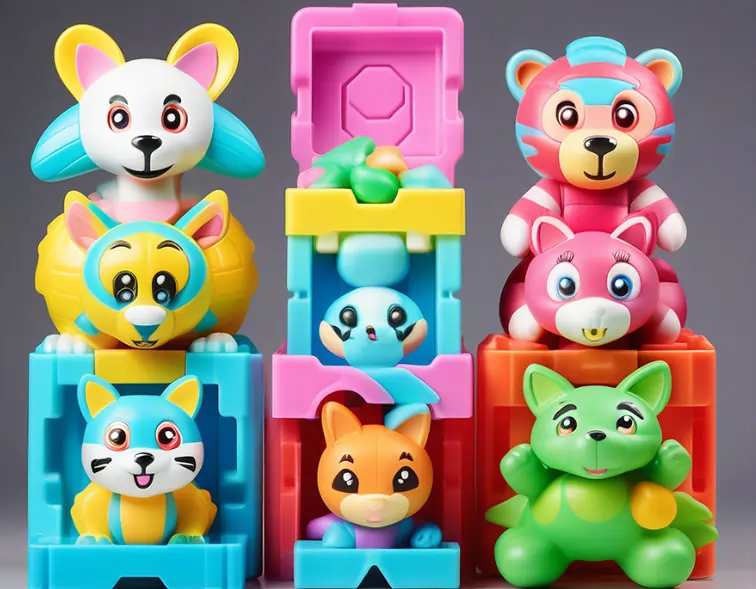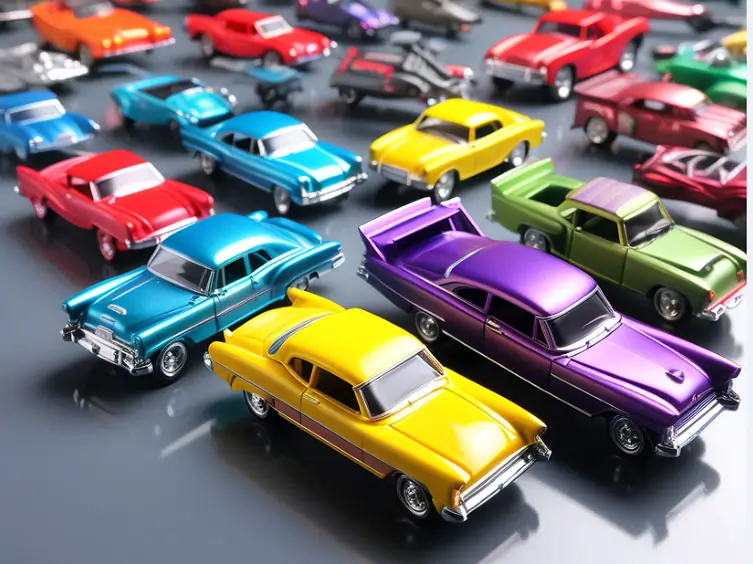The Role of Plastic Molding and Die Cast Toys in the Toy Industry
The toy industry has seen remarkable advancements in manufacturing processes, particularly in the production of plastic injection molded and die-cast toys. Plastic injection molding and die casting are pivotal in creating a wide array of toys that have captured the imagination of children and adults alike. These manufacturing processes have revolutionized the toy industry, enabling the creation of intricate and durable toys that have become perennial favorites.
Plastic Injection Molding Toys
The plastic injection molding process has become a cornerstone of toy manufacturing, offering unmatched versatility, precision, and cost-effectiveness. Simultaneously, die-cast models have carved a unique niche in the toy market, captivating enthusiasts with their exceptional detailing and durability. Understanding the significance of these manufacturing processes is crucial in appreciating the evolution of the toy industry and its impact on consumer experiences.

Advantages of plastic injection molding toys
Plastic injection molding offers numerous advantages for the production of plastic molding toys, making it a preferred manufacturing method in the toy industry. Some of the key advantages of plastic injection molding toys include:
1. Precision and Detail: Plastic injection molding enables the creation of toys with intricate designs and fine details, allowing for the replication of complex shapes, textures, and features. This precision contributes to the aesthetic appeal and realism of the toys, enhancing their visual appeal and play value.
2. Material Versatility: Plastic injection molding accommodates a wide range of plastic resins, offering flexibility in material selection to meet specific toy requirements. This versatility allows for the production of toys with varying characteristics, such as flexibility, durability, and color options, catering to diverse consumer preferences.
3. Cost-Effectiveness: Plastic injection molding is a cost-effective manufacturing process, particularly for high-volume production runs. The ability to mass-produce toys efficiently and consistently results in economies of scale, reducing per-unit production costs and making toys more affordable for consumers.
4. Durability and Strength: Toys manufactured through plastic injection molding are known for their durability and structural integrity. The process produces toys with robust construction, making them resistant to wear and tear, and capable of withstanding the rigors of play, contributing to their longevity and value.
5. Consistency and Reproducibility: Plastic injection molding ensures consistent quality and reproducibility of toys across production batches. The process allows for tight control over manufacturing parameters, resulting in uniformity in size, shape, and surface finish, maintaining high standards of quality.
6. Rapid Production Cycles: Plastic injection molding facilitates rapid production cycles, enabling swift turnaround times for toy manufacturing. This agility is particularly advantageous for meeting market demands, introducing new toy designs, and responding to consumer trends in a timely manner.
7. Design Flexibility: The plastic injection molding process offers design flexibility, allowing for the creation of toys with complex geometries, multi-part assemblies, and integrated features. Design modifications can be implemented relatively easily, providing opportunities for innovation and creativity in toy development.
8. Environmental Considerations: With increasing emphasis on sustainability, advancements in plastic injection molding have led to the adoption of eco-friendly practices, such as the use of biodegradable plastics and recyclable materials, aligning with environmental stewardship efforts.
The advantages of plastic injection molding in toy manufacturing contribute to the production of high-quality, visually appealing, low-price, and durable toys that cater to diverse consumer preferences while maintaining cost-efficiency and sustainability.
Related: Toys and Games for Kids
Die Cast Toys
Die casting is another prominent manufacturing process utilized in the toy industry, particularly for creating aluminum die-casting or zinc die-casting toys. It involves forcing molten metal alloys into a die-casting mold cavity under high pressure, resulting in detailed and durable toys. Die-cast toys are renowned for their high level of intricacy and strength, making them highly sought after by collectors and enthusiasts. The process allows for the production of toys with precise dimensions and intricate designs, making it a preferred method for creating metal toys.

Advantages of Die Cast Toys
Die-cast toys offer several advantages that make them highly desirable for collectors, hobbyists, and consumers. Some of the key advantages of die-cast toys include:
1. Realism and Detail: Die-casting allows for the creation of highly detailed and realistic toy replicas. The process captures intricate features, textures, and proportions, resulting in toys that closely resemble their real-life counterparts. This attention to detail enhances the visual appeal and authenticity of the toys, making them prized collectibles.
2. Durability and Weight: Die-cast toys are known for their durability and substantial weight. The use of metal alloys, such as zinc, aluminum, or magnesium, provides a solid and robust feel to the toys, giving them a sense of quality and longevity. This durability ensures that die-cast toys can withstand handling and play, making them suitable for both display and interactive use.
3. Collectibility and Value: Die-cast toys are often sought after by collectors due to their craftsmanship and historical significance. Many die-cast toy models are produced in limited quantities, leading to their value appreciation over time. Collectors often treasure these toys as investments and as a way to preserve automotive, aviation, or other cultural heritage.
4. Versatility and Range: Die-casting allows for the production of a wide range of toy models, including vehicles, aircraft, machinery, and figurines. The versatility of die-cast toys caters to diverse interests and hobbies, offering a broad selection for collectors and enthusiasts to choose from.
5. Scale Accuracy: Die-cast toys are commonly produced in various scales, such as 1:18, 1:24, and 1:64, allowing for accurate representations of real-world objects in miniature form. This scale accuracy is appreciated by collectors and hobbyists who value precision and authenticity in their toy collections.
6. Customization and Personalization: Die-casting enables the creation of customizable and personalized toy models. Manufacturers and collectors can produce limited-edition or custom-designed die-cast toys, adding a unique and exclusive element to the collectibles market.
7. Historical and Educational Value: Die-cast toys often depict historical, classic, or iconic vehicles and machinery, serving as educational tools that showcase cultural and technological milestones. These toys offer a tangible way for enthusiasts to appreciate and learn about the evolution of transportation and industrial design.
8. Quality Craftsmanship: Die-casting involves precision engineering and meticulous attention to detail, resulting in high-quality toy models that reflect superior craftsmanship. The manufacturing process ensures that die-cast toys exhibit consistent quality and aesthetic appeal.
As the die-casting industry continues to innovate and evolve, die-cast toys will remain a popular choice for enthusiasts seeking meticulously crafted and visually captivating models that celebrate a wide array of subjects and themes.
Processing of Die Cast Models
The processing of die-cast models or die-cast toys involves a specialized manufacturing method known as die casting, aluminum die casting or zinc die casting, which is used to create metal components with high precision and intricate details. Die-cast models, such as scale replicas of vehicles, machinery, and other objects, are popular among collectors and enthusiasts due to their realistic appearance and fine craftsmanship. The die-casting process for creating these models typically involves the following key steps:
1. Tooling Design and Creation: The process begins with the design and fabrication of the die-casting mold, also known as the die or tooling. The die is typically made from hardened steel and consists of two halves, the cover die and the ejector die, which are precision-machined to form the desired shape of the model.
2. Melting and Injection of Metal: The selected metal alloy, often zinc, aluminum, or magnesium, is melted in a furnace to its liquid state. The molten metal is then injected into the die cavity under high pressure using a specialized die-casting machine. The high pressure ensures that the metal fills the mold completely, capturing the intricate details of the model.
3. Cooling and Solidification: Once the molten metal has been injected into the die cavity, it is rapidly cooled to solidify and take on the shape of the mold. The cooling process is carefully controlled to ensure that the metal solidifies uniformly and without defects, resulting in a high-quality die-cast model.
4. Ejection and Trimming: After the metal has solidified, the die is opened, and the newly formed die-cast model is ejected from the mold. Any excess metal, known as flash, is trimmed off, and the model undergoes additional finishing processes to remove any imperfections and enhance its appearance.
5. Surface Finishing: Depending on the desired appearance of the die-cast model, various surface finishing techniques may be applied. This can include polishing, painting, plating, or other decorative treatments to achieve the desired aesthetic qualities and realism.
6. Quality Control: Throughout the entire manufacturing process, stringent quality control measures are implemented to ensure that each die-cast model meets the specified design criteria and industry standards. This includes inspections for dimensional accuracy, surface finish, and material consistency.
The die-casting process for creating models offers several advantages, including the ability to produce intricate and detailed components with high dimensional accuracy, excellent surface finish, and structural integrity. Additionally, die-cast models benefit from the durability and weight of the metal, enhancing their realism and value to collectors and enthusiasts.
Difference between Plastic Injection Molding Toys and Die Cast Toys
Plastic injection molding toys and die-cast toys are two distinct manufacturing processes that result in toys with different characteristics. Here are the key differences between the two:
1. Material: Plastic injection molding toys are made from molten plastic resin, while die-cast toys are made from molten metal alloys, such as zinc, aluminum, or magnesium. This fundamental difference in material contributes to variations in weight, feel, and finish between the two types of toys.
2. Production Process: In plastic injection molding, molten plastic is injected into a mold cavity, where it cools and solidifies to form the toy. Die casting, on the other hand, involves injecting molten metal into a mold cavity under high pressure, resulting in a detailed and solid metal toy replica.
3. Detail and Realism: Die-cast toys are known for their high level of detail and realism due to the precision of the die-casting process, which captures intricate features and textures. Plastic injection molding can also produce detailed toys, but die-cast toys often have a more substantial and realistic feel due to the use of metal.
4. Weight and Durability: Die-cast toys are typically heavier and more durable than plastic injection-molded toys due to the density and strength of metal. This makes die-cast toys suitable for both display and interactive play, while plastic toys may be lighter and more prone to breakage.
5. Surface Finish: Die-cast toys often have a smooth and polished surface finish, reflecting the quality of the metal and the precision of the die-casting process. Plastic injection-molded toys can also have a smooth finish, but the appearance and texture may differ from die-cast toys.
6. Collectibility and Value: Die-cast toys are often highly valued by collectors due to their craftsmanship, material, and historical significance. Plastic injection-molded toys can also be collectible, but die-cast toys are often perceived as higher-end collectibles due to their metal construction and attention to detail.
7. Customization: Both plastic injection molding and die casting allow for customization, but die-cast toys may offer more opportunities for limited-edition or custom-designed models due to the versatility of metal alloys and the precision of the die-casting process.
Overall, while both plastic injection molding and die casting are capable of producing high-quality toys, the choice between the two manufacturing processes ultimately depends on the desired characteristics, material preferences, and target audience for the toys. Each process offers unique advantages and considerations that cater to different market segments and consumer preferences.
Conclusion
Plastic molding and die casting play a pivotal role in shaping the toy industry, offering a diverse range of toys that cater to the preferences of consumers. As market trends continue to evolve and environmental considerations become increasingly important, manufacturers are poised to innovate and adapt to meet the demands of a changing landscape. The future of plastic molded and die-cast toys holds promise, with a focus on sustainability and technological advancements driving the industry forward. These manufacturing processes will continue to be integral in creating the toys that bring joy and inspiration to generations of children.

